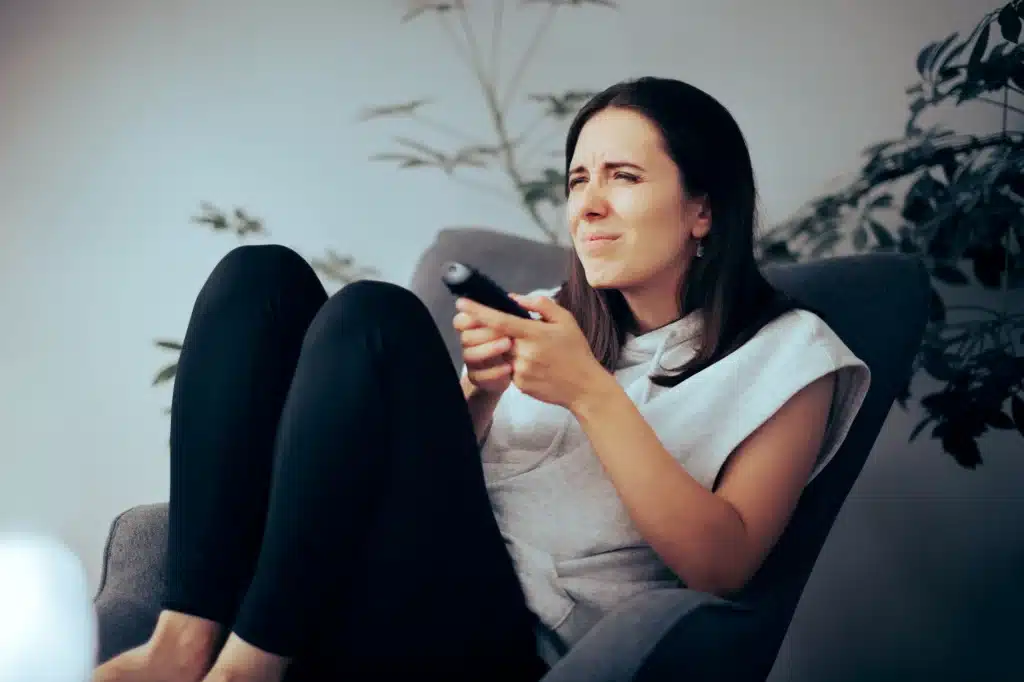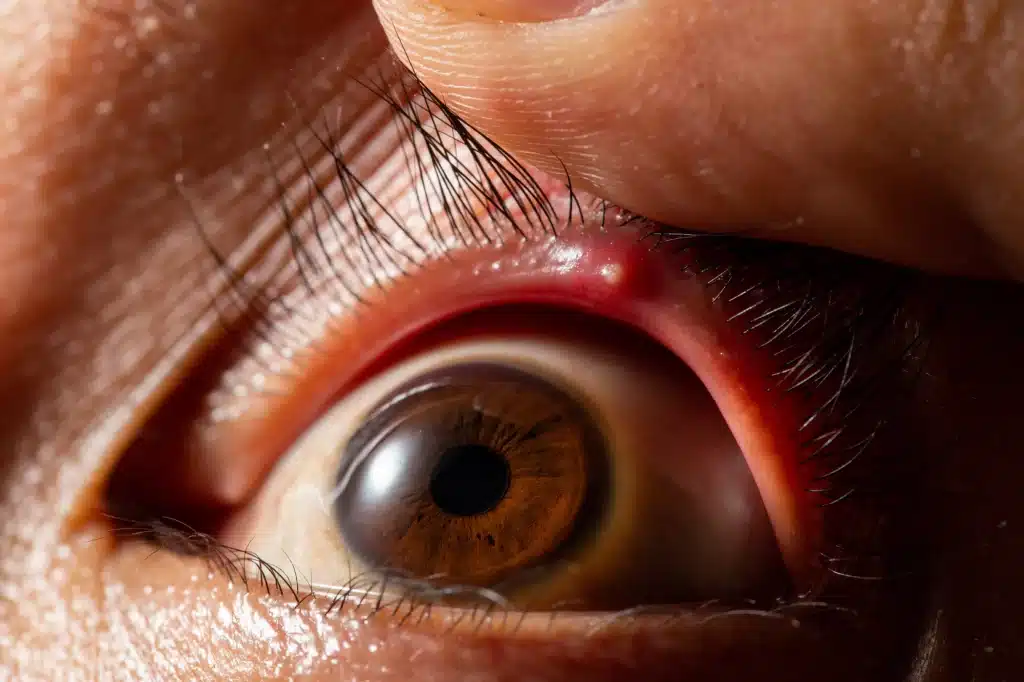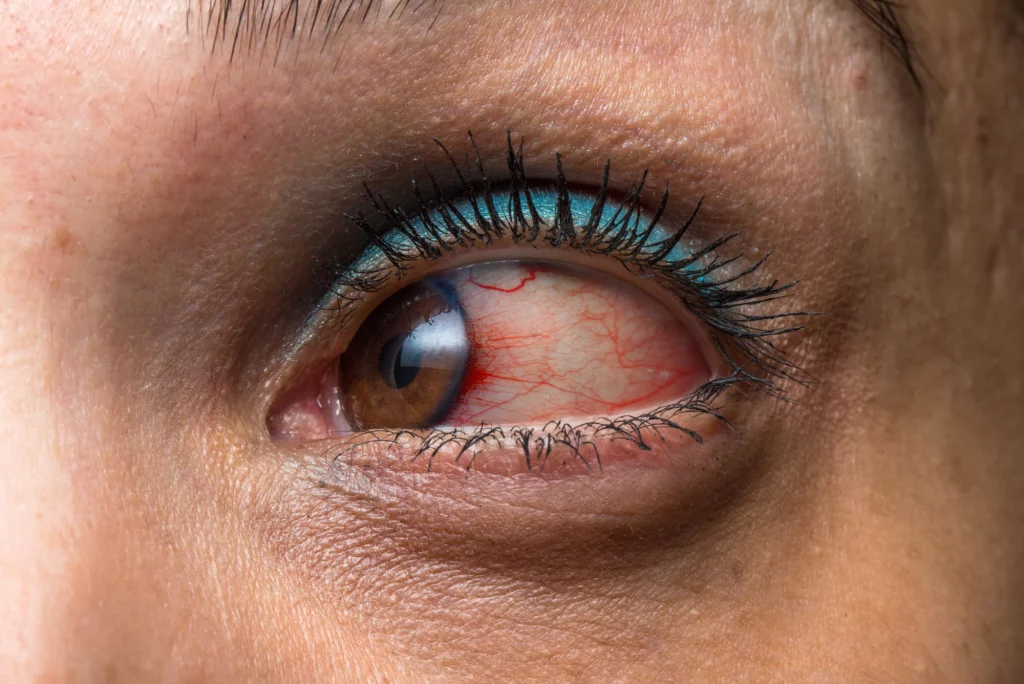Medically Reviewed by: Edward C. Wade, M.D., F.A.C.S.
Why Is There a Bump on My Eyelid?
The presence of a bump on the eyelid can be concerning and uncomfortable. It may even cause pain, irritation, or blurry vision. But what exactly causes these bumps to appear? Is it something serious or just a common occurrence?
Most small bumps on the eyelid are caused by a condition known as stye. Styes are red, inflamed bumps that often form along the edge of the eyelid. They can be caused by a bacterial infection in the hair follicle or oil gland on the eyelid. Styes can also result from poor hygiene, chronic blepharitis (inflammation of the eyelids), or an allergic reaction.
But a stye isn’t always the culprit of an eyelid bump. In this article, the ophthalmologists from Eye Center of Texas are here to offer possible reasons for a bump on your eyelid and advise on what you can do about it.
Why do I have a bump on my eyelid?
To help identify what kind of eye bump you have, pay attention to the following:
- Where is the bump? For example, is the bump on your upper eyelid?
- Is it accompanied by other bumps?
- Is the bump painful?
- What color is the bump?
- Has the bump changed or grown in size?
As mentioned, more often than not, the large or small bump on your eyelid is caused by a stye. While styes are usually harmless and will clear up on their own within a week, they may also require medical treatment if they become severely inflamed or cause vision problems.
What does a stye look like?
A stye is typically a small, red bump on the eyelid that resembles a pimple or boil. They typically form on the outside rim of your eyelid along the lash line, although they do occasionally form on your inner eyelid.
Styes on the eyelid occur when an eyelash follicle becomes inflamed or infected and clogs the oil glands in an eyelash follicle. You are more likely to get a stye if you are experiencing stress, fluctuations in hormone levels, or suffer from blepharitis (inflammation of the eyelash follicles) or rosacea.
Because styes are caused by a bacterium (typically staphylococcus), they are contagious and can be easily spread through contact. So if you have a stye, it is important to avoid touching your eyes and maintain good hygiene practices.
Reasons for a bump on eyelid that’s not a stye
If you have a bump on the eyelid and know it’s not a stye, you may have one of the following conditions instead:
- Chalazion: A chalazion is a small, painless bump that forms when the oil gland in the eyelid becomes blocked or clogged. Unlike styes, chalazia usually grow farther from the edge of the eyelid and can become quite large without causing much discomfort. You are more likely to get a chalazion if you suffer from meibomian gland dysfunction, blepharitis, rosacea, or diabetic retinopathy.
- Cyst: A cyst is a fluid-filled sac that can develop on the eyelid, often caused by blocked oil glands or hair follicles. Unlike styes and chalazia, cysts are usually painless unless they get infected.
- Xanthelasma: Xanthelasma is a type of yellowish bump that develops on the eyelid due to an accumulation of cholesterol and fat. These patches either stay the same size or can grow larger and they do not go away on their own. This condition is fairly rare and usually benign but may be a sign of high cholesterol levels.
- Milia: Milia are small, white bumps that often appear on the eyelids or around the eyes. While milia occurs most frequently in infants, you can have milia at any age. They are caused by trapped dead skin cells and are not harmful or contagious. If you have white bumps on the eyelid that do not grow, it is likely milia.
- Blepharitis: Chronic blepharitis can also cause bumps on the eyelids, especially if there is a buildup of bacteria or oil in the eyelash follicles.
- Allergic reaction: If you have recently used a new eye product or been exposed to an allergen, it’s possible that your eyelid bump is a result of an allergic reaction.
- Skin tags: Commonly found on the eyelids, skin tags are small, flesh-colored growths that hang off the skin. They are typically harmless and can be removed for cosmetic purposes if desired.
Whether or not you are sure of the cause of the bump on your eyelid, it’s best to seek medical advice from an ophthalmologist near you. They will be able to properly diagnose the issue and provide appropriate treatment if needed.
How do I get rid of a bump on my eyelid?
To effectively treat a bump on your eyelid, it is important to first identify the cause. Styes, chalazia, and milia all frequently go away on their own, though there are some things you can do at home to expedite the process. Some common remedies include:
- Warm compress: A warm compress can help to reduce swelling and encourage the stye, chalazion, or cyst to come to a head and drain.
- Eyelid scrubs: If you have a bacterial infection, your ophthalmologist may recommend using an eyelid scrub to clean the area. These gentle cleansers can also help to reduce inflammation and keep the area clean while healing.
- Antibiotics: For more severe cases, your doctor may prescribe antibiotic ointment or eye drops to treat the infection.
- Avoid wearing makeup or using contact lenses: It’s important to avoid wearing eye makeup or contact lenses while you have a bump on your eyelid. This can further irritate the area and increase the risk of spreading the infection.
If the bump on your eyelid won’t go away, returns frequently, begins to obstruct your vision, causes bleeding, or is accompanied by a change in the color of the white of your eyes, it’s best to see an eye doctor as soon as possible.
In-office treatments and procedures for eyelid bumps
In some cases, a bump on your eyelid may require in-office treatment or minor surgery to remove it. Procedures for eyelid bumps can include:
- Incision and drainage: If the bump is large and not responding to other forms of treatment, your doctor may perform a minor procedure to make an incision and drain the pus from the stye, chalazion, or cyst.
- Cauterization: For recurrent styes or chalazia, your doctor may recommend a minor procedure to cauterize the affected oil gland. This can help to prevent future outbreaks.
- Cryotherapy: Cryotherapy involves freezing the bump with liquid nitrogen to remove it. This is typically used for smaller bumps like milia and skin tags.
- Laser therapy: Laser therapy is used to remove larger bumps or growths, or for cosmetic purposes to reduce scarring after a procedure.
It’s important to note that these procedures should only be performed by a qualified ophthalmologist. Attempting to remove a bump on your eyelid at home can lead to further infection and complications. Always consult with a medical professional before attempting any form of treatment or removal.
Prevention and self-care tips for eyelid bumps
The best way to prevent eyelid bumps is to maintain good hygiene practices, especially when it comes to your eyes. This includes:
- Washing your hands: Always wash your hands before touching your eyes or applying any eye products.
- Removing makeup: Make sure to properly remove all makeup from your eyes before going to bed. This will prevent bacteria from building up on the eyelids.
- Avoid sharing eye products: Sharing eye makeup or other products can increase the risk of spreading bacteria and causing infection.
- Clean contact lenses properly: If you wear contact lenses, make sure to clean and disinfect them regularly according to your doctor’s instructions.
- Use a warm compress: Regularly using a warm compress can help prevent the buildup of oil and bacteria on the eyelids.
By following these self-care tips and maintaining good eye hygiene, you can reduce your risk of developing eyelid bumps. It’s also important to address any underlying issues that may be causing frequent outbreaks, such as blepharitis or allergies.
Concerned about a bump on your eyelid? Call Eye Center of Texas.
If you have a bump on your eyelid that is causing discomfort, vision changes, or will not go away, it’s important to seek medical attention from an experienced ophthalmologist.
At Eye Center of Texas, our team of world-class eye doctors can properly diagnose and treat any issues with your eyelids and provide personalized care for optimal results. We have office locations throughout Texas including in Houston, Pasadena, Sugar Land, Clear Lake, Katy, and The Woodlands.
Whether you’re concerned about chronic red under eyes, think you may be experiencing glaucoma symptoms, or have a small bump on your eyelid that just won’t go away, we are here to help put your mind at ease. Request an appointment with us today!
More Helpful Articles by Eye Center of Texas:
- How to Find a Good Cataract Surgeon in Houston
- What to Look For to Find the Best LASIK in the World
- Where to Find the Best Cataract Surgery in Conroe, Texas
- How to Fight Fast Growing Cataracts
- How Long is the EVO ICL Recovery Time?
Related Articles
Financing Options Available
Apply today to find a financing option that meets your needs.
Our Locations
Houston/Bellaire
6565 W. Loop S., Suite 650Bellaire, TX 77401
Medical Office:
713-797-1010
Medical Fax:
713-357-7276
LASIK/Near Vision:
Office: 713-395-1515
Fax: 713-357-7278
Pasadena
4415 Crenshaw RoadPasadena, TX 77504
Medical Office:
281-977-8800
Medical Fax:
281-977-8877
Sugar Land
15200 S.W. Freeway, Suite 130Sugar Land, TX 77478
Medical Office:
281-277-1010
Medical Fax:
281-277-4504
Clear Lake
455 E. Medical Center Blvd., Suite 110Webster, TX 77598
Medical Office:
281-332-1397
Medical Fax:
281-282-9152
Katy
Greenhouse Medical Plaza2051 Greenhouse Road, Suite 110
Houston, TX 77084
Medical Office:
346-547-7070
Medical Fax:
281-214-2971
The Woodlands/Conroe
100 Medical Center Blvd., Suite 118Conroe, TX 77304
Medical Office:
936-647-1610
Medical Fax:
936-647-1620


